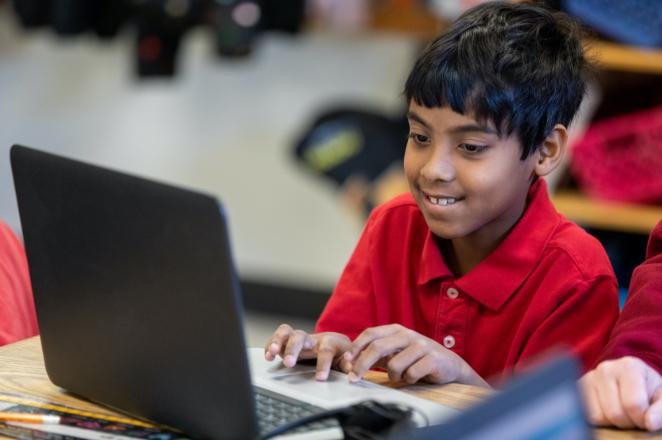Learning to Code, One Dancing Cat at a Time
Their control pads were ready. Their avatars’ energy levels were full. Excitement filled the air as second grade students at Isely Elementary worked to beat level 1: making a cat dance. Next up, adding pineapples and unicorns to their digital dance party.
While dancing cats, fruit and mythical creatures may not seem educational at first, this is an exercise to teach students the basics of coding. By assembling strings of code, these second graders create on-screen characters that respond to keyboard commands, syncing a disco cat with a dabbing unicorn by a simple press of the ‘up’ and ‘down’ arrows on their keyboards.
“I like it because you can choose characters and the background. And because pineapples are involved,” said an Isely student, Josh, as a pineapple avatar danced on his screen. He showed off both his coding and his dance moves, flossing and bopping right along with his pineapple.
“I like that you get to make your own dance moves and characters, and then get them to do what you want them to do,” said a student named Mia. She wants to continue exploring coding because “you can make your own things.”
The majority of schools don’t teach code or computer science, according to Code.org. Just 45% of high schools have computer science programs, even though 67% of all new STEM (science, technology, engineering, and math) jobs are in computing. Demand for computer science as a career is high in every state and every industry — and projected to grow at twice the rate of all other jobs in the future.
This gap in preparing tomorrow’s workforce is why Koch supports programs – like Code.org – to help students discover new talents and abilities preparing them for their future. And why Code.org hosts “Hour of Code” events at every grade level across the country. This year several Koch Industries employees helped bring “Hour of Code” events to classrooms in Kansas.
Mrs. Janice Smith’s second grade classroom participated in the Hour of Code activity during Computer Science Education Week. Seeing the importance of computer science education to future success firsthand, volunteers Carissa Spencer and Josh Remacle, both part of Koch’s digital workforce team, led the “Hour of Code” in Mrs. Smith’s class.
“Coding allows students to practice critical thinking and problem-solving skills in an engaging way,” said Mrs. Smith. “Exposure to events like this and this technology helps them to be future-ready.”
The creativity involved in coding their own dance party engaged the students’ curiosity while experiencing computer science for the first time. This introduction to code is far above what many of today’s computer science professionals experienced in school.
“When I was exposed to code, it just wasn’t very exciting. It wasn’t very fun because there weren’t a lot of technical applications,” said Spencer, now a digital workforce analyst. “I think it’s important for kids to see how creativity and computer science really tie together.”
Cloud computing was named the most valued hard skill in 2019, according to LinkedIn’s research. A 2017 analysis of American manufacturers’ job postings by Burning Glass Technologies revealed that openings for software jobs were now outpacing production jobs. Embracing this shift to computing, tech and automation is what Remacle and Spencer help Koch employees do every day, both assisting employees to automate processes using computer science skills.
“I help everyone on different levels of experience and knowledge to connect to the ability for them to automate parts of their work so they can focus more time on creating value in the ways that are most meaningful to them,” said Spencer. “It’s applied computer science in the real world.”
Remacle, who volunteered along with Spencer, was first introduced to coding when his job at Koch was created — a role that, like Spencer’s, didn’t even exist three years ago.
“The work we’re doing is changing. If we don’t harness and leverage it, then change will happen to us, not because of us. It’s important for us as change leaders to wrap our heads around that and see what that change can look like for each of us individually,” said Spencer.
“Today's second graders are already training on how to code dancing cats. When they enter the workforce, their ability to be more effective in driving business results is going to be so far beyond what we even understand today,” said Remacle.
Remacle relished in the students’ excitement and knew his younger self would have appreciated exposure to an activity like this. The ease of teaching the lesson and the positive responses from the students were encouraging for both Remacle and Spencer, who look forward to introducing an “Hour of Code” to other schools.
“Combining dancing animals and music?” asked Spencer, “I don’t know how you go wrong.”







